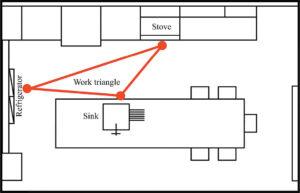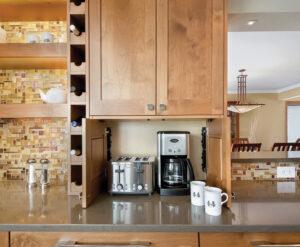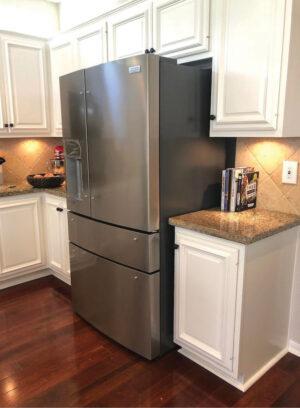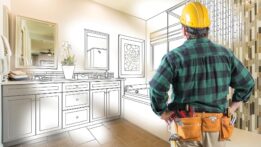When it comes to remodeling your kitchen, there is much more to think about than backsplash and countertops. As the center of the home where you cook meals, bond with family, and serve guests, kitchens should both fit your home aesthetic and be designed for functionality. If you are considering remodeling your kitchen, then read on for the dos and don’ts of appliance placement that will help get you started.
Do Talk with Your Contractor Ahead of Time
Planning with your contractor ahead of time to verify that your design is doable will save you a lot of disappointment later. A contractor will be able to tell where appliances can go based on access points for plumbing, gas, and electricity. In addition, working with contractors on appliance layout allows them to brainstorm creative ideas to get as close as possible to what you want.
Do Create a Work Triangle
 The number one “Do” of kitchen design is creating a “Work Triangle” with large appliances. This triangle usually includes the fridge, sink, and stove as the main appliances used when working in the kitchen. The word triangle does not imply that you must arrange these appliances to create that shape but mostly refers to the idea that there are three main work stations. Generally, when cooking you will move from the prep area to the cooking area and finally to the cleanup area. Many times, you will go back and forth between the prep and cooking areas in one session. Maybe your three most used appliances are slightly different. This is ok. Just make sure that when you place your main appliances, there is a clear route leading between them. Avoid things like having to move around an island in order to get to your next station. If you know that when you cook, you often go from the fridge for ingredients to prep in the sink before cooking on the stove, place these appliances in a way that allows you to move easily from the first to the last in order. This creates a smooth work flow when you cook. For small kitchens, it may be best to place your main three appliances on one wall with a prep space on the other side. Think about what layout will work best with your space and cooking habits.
The number one “Do” of kitchen design is creating a “Work Triangle” with large appliances. This triangle usually includes the fridge, sink, and stove as the main appliances used when working in the kitchen. The word triangle does not imply that you must arrange these appliances to create that shape but mostly refers to the idea that there are three main work stations. Generally, when cooking you will move from the prep area to the cooking area and finally to the cleanup area. Many times, you will go back and forth between the prep and cooking areas in one session. Maybe your three most used appliances are slightly different. This is ok. Just make sure that when you place your main appliances, there is a clear route leading between them. Avoid things like having to move around an island in order to get to your next station. If you know that when you cook, you often go from the fridge for ingredients to prep in the sink before cooking on the stove, place these appliances in a way that allows you to move easily from the first to the last in order. This creates a smooth work flow when you cook. For small kitchens, it may be best to place your main three appliances on one wall with a prep space on the other side. Think about what layout will work best with your space and cooking habits.
Do Place Small Appliances Second
 Once you have figured out the placement for your top three appliances, start placing other less frequently used ones around them. Integrating smaller appliances into your original work triangle keeps your workflow smooth and uninterrupted. For example, placing the microwave or oven near the stove will allow you to keep your cooking appliances together. Smaller countertop appliances, such as blenders or toasters, should be placed based on frequency of use. A scarcely used blender may fit best in a bottom cabinet while an often-used toaster may be best on the counter top by a coffee machine. When placing appliances on the countertop, make sure to give enough space to work with each comfortably. You may not want to have three frequently used appliances all in one corner, especially if they all must be plugged in to one outlet. If you have many useful appliances but simply cannot stand the sight of countertop clutter, consider putting in an appliance garage. This way, you can have your favorite appliances out of sight but still easily accessible.
Once you have figured out the placement for your top three appliances, start placing other less frequently used ones around them. Integrating smaller appliances into your original work triangle keeps your workflow smooth and uninterrupted. For example, placing the microwave or oven near the stove will allow you to keep your cooking appliances together. Smaller countertop appliances, such as blenders or toasters, should be placed based on frequency of use. A scarcely used blender may fit best in a bottom cabinet while an often-used toaster may be best on the counter top by a coffee machine. When placing appliances on the countertop, make sure to give enough space to work with each comfortably. You may not want to have three frequently used appliances all in one corner, especially if they all must be plugged in to one outlet. If you have many useful appliances but simply cannot stand the sight of countertop clutter, consider putting in an appliance garage. This way, you can have your favorite appliances out of sight but still easily accessible.
Don’t Forget About Doors and Drawers
A common mistake when placing appliances is forgetting to accommodate for the space needed to open them. You may have placed the fridge too close to the wall for it to open all the way or positioned the dishwasher too close to the corner for the bottom cabinets and it to be opened at the same time. A contractor should be able to point out and avoid these mistakes in reviewing the design, but it is still good for you to be looking out for them as well. However, these mistakes are nearly impossible to find if you do not have the measurements for your appliances when you plan your layout. You should measure all the appliances being used before beginning to design anything. This goes for small countertop appliances too. Measuring just about everything you plan to have on the counter is a good way to make sure you give yourself enough counter space without things looking cluttered.
Don’t Let Appliances Protrude
 After ensuring all the appliances can be opened and closed properly, do not forget to make sure they are flush with their surroundings. A fridge door may open just fine in the place you put it but protrude from the spot. Having any appliance stick out past your counters or other appliances is unappealing. It can also mess with the flow of foot traffic depending on how small the kitchen is and how far out the appliance goes.
After ensuring all the appliances can be opened and closed properly, do not forget to make sure they are flush with their surroundings. A fridge door may open just fine in the place you put it but protrude from the spot. Having any appliance stick out past your counters or other appliances is unappealing. It can also mess with the flow of foot traffic depending on how small the kitchen is and how far out the appliance goes.
Appliance placement should be at the core of every kitchen’s design in order to maximize work flow. This helps create a space you and your family will love to do life in. Once you know where the appliances go, the rest will follow. ![]()
Jamie Soto
Home & Yard Magazine




